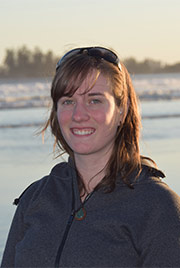A walk in the woods: Land of giants among dinosaurs
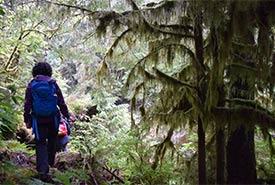
Walking through a BC forest dripping with witch's hair lichen (Photo by NCC)
I have been fortunate enough to live in some of the most beautiful parts of British Columbia, from the Rockies to the west coast.
My life began in the Kootenays in the shadow of the Rocky Mountains, among slopes blanketed in montane and Columbia forests. I then spent my childhood in the dry south Okanagan, where my neighbourhood forests consisted of Douglas-fir and vanilla-scented ponderosa pines, or “puzzle trees,” as I fondly called them due to their puzzle-like pieces of bark.
When I was 15, a family move whisked me away from my arid paradise to Vancouver Island, and this is where my education and true appreciation of coastal forests began.
As a child from the interior, I was in awe of the perpetual green found on the west coast. It did not take long to discover the reason behind the lush, evergreen vegetation dominating the landscape: this desert girl had moved to a rainforest.
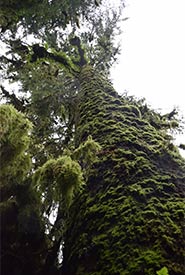
Mossy Sitka spruce, Gullchucks Estuary, BC (Photo by NCC)
The temperate rainforest climate that runs along BC’s west coast is a product of the Pacific Ocean and the Coast Mountains and Cascade Range. The mild ocean air pushes moisture-heavy clouds directly into the wall made by the Coast Mountains. Like a hand squeezing a sponge, the mountains force the clouds to unload their wet burden before heading inland to BC’s interior. Some places, like Haida Gwaii and the Central Coast Rainforest, can receive as much as five metres of rain per year. The results of these powerful forces are our lush, wet coastal forests dominated by evergreen, coniferous trees that photosynthesize all year long, even in winter, allowing them to grow into forests of giants.
While the endless drizzle was a bit of a rude awakening after living in a semi-desert climate, I overcame my adversity for rain and clouds by spending time in the coastal forests and learning more about the results of this relationship between land and sea. During university, I was drawn outside to learn more about the species that rely on our coastal forests and the diversity that can be found within this region.
For all its famed wetness, the BC coast is also home to the drier and endangered coastal Douglas-fir forests and Garry oak woodlands, such as the Nature Conservancy of Canada’s (NCC’s) Cowichan Garry Oak Preserve or Chase Woods Nature Preserve. The iconic ”wet coast” coastal western hemlock forests are the most abundant of coastal forests, but still in need of conservation attention (see NCC’s Clayoquot Island Preserve or Kumdis River Conservation Area). And we can’t forget the higher-elevation mountain hemlock forests that hug the snowy slopes. This intriguing variety and inspiring natural beauty, coupled with my educational pursuits, led me to my role as NCC’s west coast stewardship coordinator.
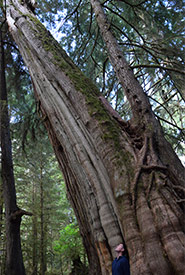
Old-growth cedar supporting a young western hemlock (Photo by NCC)
Now I spent time monitoring NCC’s coastal forest properties among others, ensuring their natural values are protected and maintained, and doing my best to observe and work with species that rely on them, including humans. Walking through old-growth forests of western red cedar, western hemlock and coastal Douglas-fir, I imagine myself striding between the legs of dinosaurs. In a sense, these forests do contain living dinosaurs that have persisted for centuries and can tower over 100 metres, if given a chance.
The coastal forests are not just about the ancient giants that comprise them though. There is life in every nook and cranny that is adapted to the west coast and has a role in the forest.
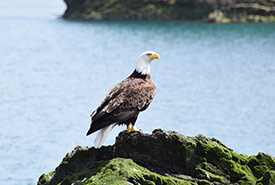
Bald eagle (Photo by NCC)
Walking through the Great Bear Rainforest on NCC’s Gullchucks Estuary this summer, I was overwhelmed by all the life teeming from treetop to forest floor. Bald eagles giggled squeakily atop Sitka spruce, witch’s hair lichen draped over every branch, a dense understory of hemlocks and red huckleberry dripped under the rain, and countless moss species of various colours blanketed tree trunks and the forest floor, all the way to the rocky streambank and shore.
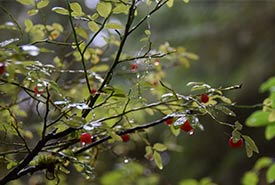
Red huckleberry (Photo by NCC)
There seemed to be little room for new growth amidst the dense moss. But looking around, I saw opportunistic plants and trees making the most out of a momentarily moss-free surface of a fallen tree, aptly called a nurse log. From death comes more life.
I made my way through the forest along a rough trail, careful not to tread in the abundant evidence of wildlife use: wolf and bear scat and the remains of salmon dragged ashore to be consumed by carnivores, and bones cleaned by ravens, eagles, insects and rain. I peered into the canopy, looking for nesting sites for marbled murrelets, which rely on coastal old-growth forests to produce a natural nest of mossy bedding in a branch close to the ocean. I saw many good places to lay an egg.
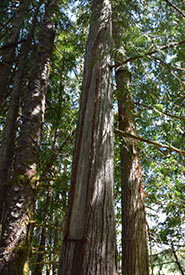
Culturally modified western red cedar (Photo by NCC)
Throughout the forest, I saw culturally modified trees – trees altered by indigenous peoples as part of their traditional use of the forest. The Heiltsuk Nation have been walking in this forest for thousands of years, and it is easy to see why. They value this productive forest and rely on the natural bounty to physically and spiritually sustain their way of life.
Gullchucks, one of many gems conserved by NCC, captures the essence of the idyllic coastal forest. It shares lessons and stories about tree giants, the natural cycle of life and death and the importance of healthy relationships. This forest stands as a productive source of silent strength.
A walk in these woods is a different adventure every time. I find myself stopping to collect salmonberries, hugging a giant tree or breathing in the cool, wet air with a hint of earthy red cedar, and I know that my future children will get to do the same.

